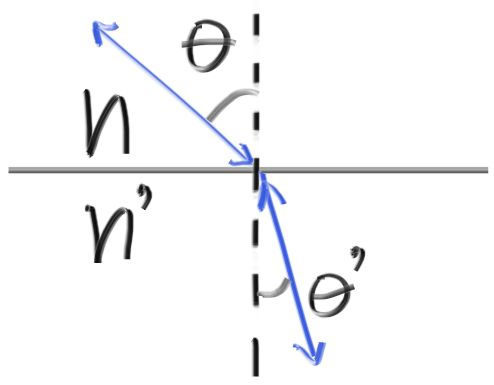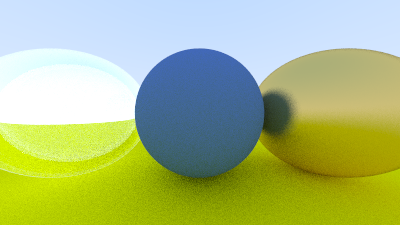这一节开始实现诸如水、玻璃、钻石等透明材质,他们都是电介质(dielectric ),光线到达电介质会发生折射,因此首先要计算折射光线。
1 折射光线
之前在图形学中我们知道,Snell‘s law 描述了折射光线和入射光线之间存在关系:
$$
\eta·sin\theta = \eta’·sin\theta’
$$

所以求解折射光线就是求解折射角 $\theta’$,$\theta’$ 是折射光线 $R’$ 和法线的夹角,我们可以把 $R’$ 分解为垂直于法线的分量和平行于法线的分量 :

然后可以根据两个分量的计算公式得到折射光线:

其中 $cos\theta$ 可以通过归一化的入射光线和法线的点乘得到,因此垂直分量可以改写为:
$$
R’_{perp} = \frac{\eta}{\eta’}(R + (-R·n) \ n)
$$
由此我们可以编写一个计算折射光线的函数:
1
2
3
4
5
6
7
|
inline vec3 refract(const vec3& R, const vec3& n, double etai_over_etat) {
auto cos_theta = fmin(dot(-R, n), 1.0);
vec3 r_out_perp = etai_over_etat * (R + cos_theta * n);
vec3 r_out_parallel = -sqrt(fabs(1.0 - r_out_perp.length_squared())) * n;
return r_out_perp + r_out_parallel;
}
|
2 电介质材质
有了折射光线计算,我们可以实现一个只计算折射光线的电介质材质:
1
2
3
4
5
6
7
8
9
10
11
12
13
14
15
16
17
18
19
20
21
22
23
|
class dielectric : public material {
public:
dielectric(double index_of_refraction) : ir(index_of_refraction) {}
virtual bool scatter(
ray& r_in, const hit_record& rec, color& attenuation, ray& scattered
) const override {
attenuation = color(1.0, 1.0, 1.0);
double refraction_ratio = rec.front_face ? (1.0 / ir) : ir;
vec3 unit_direction = normalize(r_in.direction());
vec3 refracted = refract(unit_direction, rec.normal, refraction_ratio);
scattered = ray(rec.p, refracted);
return true;
}
public:
double ir;
};
|
然后修改场景,将中间和左边的球体材质更换为电介质,设置折射率为1.5,模拟玻璃材质:
1
2
3
4
5
6
7
8
9
10
|
hittable_list world;
auto material_ground = make_shared<lambertian>(color(0.8, 0.8, 0.0));
auto material_center = make_shared<dielectric>(1.5);
auto material_left = make_shared<dielectric>(1.5);
auto material_right = make_shared<metal>(color(0.8, 0.6, 0.2), 1.0);
world.add(make_shared<sphere>(point3(0.0, -100.5, -1.0), 100.0, material_ground));
world.add(make_shared<sphere>(point3(0.0, 0.0, -1.0), 0.5, material_center));
world.add(make_shared<sphere>(point3(-1.0, 0.0, -1.0), 0.5, material_left));
world.add(make_shared<sphere>(point3(1.0, 0.0, -1.0), 0.5, material_right));
|
得到的结果如下:

这看起来显然是不对的,因为我们现在只计算了折射光线,但是当介质折射率较大的时候,有可能存在无法发生折射的情况,也就是 $\theta’$ 无解,比如上面的玻璃,折射率为 1.5,那么:
$$
sin\theta’ = \frac{1.5}{1}sin\theta
$$
可能出现 $sin\theta’$ 大于 1 的情况,此时不会发生折射,这个现象我们在图形学中也有学过。
因此我们需要在材质的散射函数中做一个判断:
1
2
3
4
5
6
7
| if (refraction_ratio * sin_theta > 1.0) {
...
} else {
...
}
|
于是修改我们的电介质材质类:
1
2
3
4
5
6
7
8
9
10
11
12
13
14
15
16
17
18
19
20
21
22
23
24
25
26
27
28
29
30
31
32
33
|
class dielectric : public material {
public:
dielectric(double index_of_refraction) : ir(index_of_refraction) {}
virtual bool scatter(
ray& r_in, const hit_record& rec, color& attenuation, ray& scattered
) const override {
attenuation = color(1.0, 1.0, 1.0);
double refraction_ratio = rec.front_face ? (1.0 / ir) : ir;
vec3 unit_direction = normalize(r_in.direction());
double cos_theta = fmin(dot(-unit_direction, rec.normal), 1.0);
double sin_theta = sqrt(1.0 - cos_theta * cos_theta);
bool cannot_refract = refraction_ratio * sin_theta > 1.0;
vec3 direction;
if (cannot_refract)
direction = reflect(unit_direction, rec.normal);
else
direction = refract(unit_direction, rec.normal, refraction_ratio);
scattered = ray(rec.p, direction);
return true;
}
public:
double ir;
};
|
然后修改场景中的材质:
1
2
3
4
| auto material_ground = make_shared<lambertian>(color(0.8, 0.8, 0.0));
auto material_center = make_shared<lambertian>(color(0.1, 0.2, 0.5));
auto material_left = make_shared<dielectric>(1.5);
auto material_right = make_shared<metal>(color(0.8, 0.6, 0.2), 0.0);
|
得到的效果如下:

3 加入菲涅尔项
现在为电介质材质加入菲涅尔项,使其随着观察角度变化发生更多的反射,依然使用 Schlick’s 近似计算菲涅尔项,修改后的最终材质类如下:
1
2
3
4
5
6
7
8
9
10
11
12
13
14
15
16
17
18
19
20
21
22
23
24
25
26
27
28
29
30
31
32
33
34
35
36
37
38
39
40
41
|
class dielectric : public material {
public:
dielectric(double index_of_refraction) : ir(index_of_refraction) {}
virtual bool scatter(
ray& r_in, const hit_record& rec, color& attenuation, ray& scattered
) const override {
attenuation = color(1.0, 1.0, 1.0);
double refraction_ratio = rec.front_face ? (1.0 / ir) : ir;
vec3 unit_direction = normalize(r_in.direction());
double cos_theta = fmin(dot(-unit_direction, rec.normal), 1.0);
double sin_theta = sqrt(1.0 - cos_theta * cos_theta);
bool cannot_refract = refraction_ratio * sin_theta > 1.0;
vec3 direction;
if (cannot_refract || reflectance(cos_theta, refraction_ratio) > random_double())
direction = reflect(unit_direction, rec.normal);
else
direction = refract(unit_direction, rec.normal, refraction_ratio);
scattered = ray(rec.p, direction);
return true;
}
public:
double ir;
private:
static double reflectance(double cosine, double ref_idx) {
auto r0 = (1 - ref_idx) / (1 + ref_idx);
r0 = r0 * r0;
return r0 + (1 - r0) * pow((1 - cosine), 5);
}
};
|
我们现在实现的电介质材质类是简化后的版本,光线打到物体上要么发生反射,要么发生折射,我们并没有同时考虑折射光线和反射光线。
4 空心玻璃球
对于玻璃球来说,如果使用负半径,几何形状不受影响,但表面法线指向内(可以回顾球体类中 hit 方法的实现)。这可以作为一个气泡来制作一个中空的玻璃球:
1
2
3
4
5
6
7
8
9
10
| hittable_list world;
auto material_ground = make_shared<lambertian>(color(0.8, 0.8, 0.0));
auto material_center = make_shared<lambertian>(color(0.1, 0.2, 0.5));
auto material_left = make_shared<dielectric>(1.5);
auto material_right = make_shared<metal>(color(0.8, 0.6, 0.2), 0.3);
world.add(make_shared<sphere>(point3(0.0, -100.5, -1.0), 100.0, material_ground));
world.add(make_shared<sphere>(point3(0.0, 0.0, -1.0), 0.5, material_center));
world.add(make_shared<sphere>(point3(-1.0, 0.0, -1.0), 0.5, material_left));
world.add(make_shared<sphere>(point3(-1.0, 0.0, -1.0), -0.4, material_left));
world.add(make_shared<sphere>(point3(1.0, 0.0, -1.0), 0.5, material_right));
|
我们向场景中左边球体内加了一个同心半径为负的球体,使它们构成了一个空心玻璃球,渲染效果如下:






